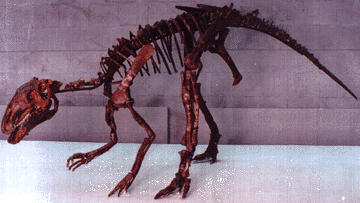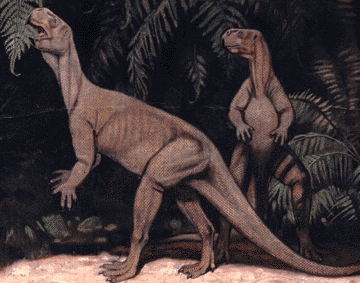
Probactrosaurus
gobiensis -Rozhdestvensky, 1966- skeleton
Archosauria: Ornithischia: Ornithopoda:
Iguanodontidae
Locality: Alashan Desert, Inner Mongolia, northern China
Age:
Early Cretaceous (AptianAlbian), 115 million years ago
Meaning of name: "before
the Bactrian reptile"
The
main peculiarity of the iguanodonts is a movable longitudinal articulation of the
upper
jaws, which allowed them to be rotated when the mouth was closed. It was
a very unusual
but effective way to chew food. In the jaw of an iguanodontid,
there is a row of functional
teeth and beneath them, another row of unerupted
teeth which gradually replaced the
functional teeth. This dentition was suitable
for cropping soft vegetation. Out of the
iguanodontids
arose the hadrosaurids or duck-billed dinosaurs. The duck-bills
had as
many as five rows of teeth in the jaw, one beneath the other. Adjacent
teeth fitted tightly
together like a set of tiles rather than being separated
to the degree found in our own
teeth or those of iguanodontids.
At any one time, one complete row of teeth would be
functioning to chew the animal's
food and worn, broken teeth were quickly replaced.
This enabled hardrosaurids
to eat much tougher vegetation than their iguanodontid
ancestors.
Probactrosaurus gobiensis is intermediate in the structure of its dentition
between
the iguanodontids and hadrosaurids.
Clearly it was a plant eater and spent some
time on all four feet, but when it
was moving fast probably travelled on its hind limbs
(bipedially). Probactrosaurus
had a very stiff back and tail as tendons with bony material
in them crisscrossed
between each vertebra-preventing much movement between them.
In the late Early
Cretaceous some iguanodots, like Probactrosaurus from Inner
Mongolia (China),
gave rise to the hadrosaurids, or duck-billed dinosaurs.





